|
|
Railroad
Postcards
Anyone who has collected railroadiana for a while has
seen a dramatic escalation in the values of rarer items. Record prices
have been set recently in hardware categories such as lanterns and
china, and even paper items such as passes and timetables have risen
markedly in value. Fortunately, those seeking a more affordable avenue
for collecting railroadiana have an alternative: postcards. Postcard-collecting
is, of course, a major hobby in its own right, with specialized organizations,
shows, and books devoted to it. However, the railroad postcard has
become a sub-category of postcard collecting, for a number of reasons:
- There are a lot of them. In the late 19th and early 20th centuries,
postcards became a major means of communication, reflecting the emergence
of good postal service and abundant railroad travel options. The first
two decades of the 20th century are often considered the "golden
age" of postcards, and this period coincided with the zenith of
rail passenger travel in America. It was common for passengers to send
postcards to friends or family to communicate their travel progress
or just to stay in contact.
- Railroads were a frequent subject of postcards. In the late 19th
and early 20th centuries, railroads and their facilities had a prominent
presence in the American landscape. Postcards of the era featured everything
from railroad engineering landmarks to small-town stations.
- People tended to keep postcards as mementos rather than throw them
away. Estate and garage sales often turn up old postcard collections,
so that the number of postcards available to the collector continues
to grow.
- Postcards are generally inexpensive relative to other railroad collectibles.
Of course like any other collectible, rarity can drive up prices, but
it is still possible to buy decent railroad postcards for a few dollars
or so.
Common Themes. There are a number of common themes or subjects
that are frequently found on railroad-related postcards, among them.....
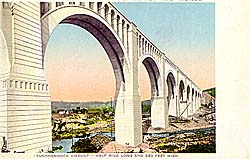 |
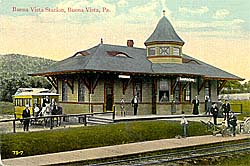 |
| Engineering Landmarks. The engineering
feats of railroad construction were a favorite subjects of postcards.
Dating from around 1915 and showing the clutter of recent construction,
this postcard reads, "On the Lackawanna Railroad - Ninth Wonder
of the world: Tunkhannock Viaduct - half mile long and 240 feet high." Click
on the image for a larger view. |
Stations. In an era when railroad
stations were the major entry and departure points for communities,
both small-town and big-city stations were the subject of postcards.
This scene, complete with horse-drawn trolley, depicts the Buena
Vista Springs station (inked on the card) although the caption reads, "Buena
Vista Station, Buena Vista, PA." Click on the image for a larger
view. |
 |
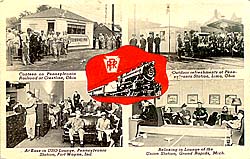 |
| Scenery. As railroads
increasingly promoted tourist and vacation travel, postcard producers
focused on scenery along railroad lines. Sometimes railroads produced
their own postcards. With nary a train in site, the subject of this
postcard is natural beauty. The caption reads, "West Index on
Great Northern Railway," a scene in the North Cascade Range
of Washington State. Click on the image for a larger view. |
Interiors. Postcards
that show interiors of stations, other railroad buildings, or rolling
stock are not very common, but they can be found. This World War
II-era card shows a number of USO scenes, including interiors of
USO lounges in the Pennsylvania Railroad's Fort Wayne, Indiana and
Grand Rapids, Michigan stations. Click on the image for a larger
view. |
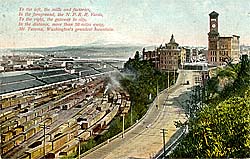 |
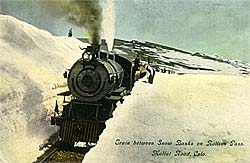 |
| Industrial Landscapes. Once
upon a time, the industrial scene was considered a mark of prosperity,
and postcards frequently showed railroad facilities in urban settings.
The caption here reads, " To the left, the mills and factories,
In the foreground, the N.P.R.R. Yards, To the right, the gateway
to the city, In the distance, more than 50 miles away, Mt. Tacoma,
Washington's grandest mountain." Today the mountain is known
as Mt. Rainier. Click on the image for a larger view. |
Troubles. Wrecks,
disasters, and other difficulties were sometimes the subject of
postcards, although we can assume these were not welcomed by railroad
management. Judging by the number of laborers in this scene, a
train on the "Moffat Road" is probably being dug out
of one of the legendary snowfalls that plagued this line over Rollins
Pass. The caption simply states, "Train between snow banks
on Rollins Pass, Moffat Road, Colo." Click on the image for
a larger view. |
Obscure Locations. One of the most interesting aspects of railroad
postcards is the fact that many show rather obscure locations and facilities.
For most railroadiana collectors, an interest in railroad history goes
hand-in-hand with collecting, and postcards can provide a glimpse into
a long-vanished past. In contrast to today's garish, tourist-oriented
postcards, many early postcards focused on rather nondescript locations,
for example a stretch of empty railroad tracks beside a river or a railroad
yard. In particular, the "real photo postcard" -- a postcard
produced from a monochrome, untinted photograph -- can function as an
historical record, sometimes the only record of a location.
Case in point: The Pittsburgh & Lake Erie (P&LE) Railroad's
Dickerson Run Yard, near Connellsville, Pennsylvania. At the turn of
the 20th Century, the P&LE developed Dickerson Run Yard to service
the extensive coal fields of the Connellsville region, then considered
the best source of coking coal in the world. The yard was located in
a narrow, remote valley of the Youghiogheny River, very much off the
beaten path. Few railroad photographers ventured into this region, and
published photographs of the yard are rare. As the Connellsville coal
fields gradually played out, the yard's strategic importance diminished,
and it was entirely abandoned in 1970. Today the site is a second-growth
forest bisected by the Youghiogheny
River Rail-Trail on the old P&LE roadbed.
With this level of obscurity, it would seem most unlikely that postcards
of the Dickerson Run Yard would have been produced, but they were. In
fact a number of them have turned up, all the more remarkable given the
fact that this P&LE division was never a major long-distance passenger
route like the nearby Baltimore & Ohio and Pennsylvania Railroad
mainlines. The images below show a number of views of the yard, the first
four dating to around 1910. The last is a reproduction of a painting
of the area produced by Howard Fogg in the 1960's on commission from
P&LE president, John Barringer. A whole series of lineside paintings
by Fogg were reproduced by the railroad in numerous formats, including
postcards.
|
|
| Above. A real photo postcard titled "Dickerson
Run Yards, Dickerson Run, PA.", with a 1910 postal cancellation
on the back. Click on the image for a larger view. |
Above. A real photo postcard titled "Partial
View, Dickerson Run and Dawson Bridge - Dickerson Run, PA.",
showing the Eastern end of the yard. The postal cancellation is dated
1911. Click on the image for a larger view. |
|
|
| Above. A real photo postcard titled "P.&.L.E.
Roundhouse & Shops, Dickerson Run, PA.", unused (no postal
cancellation). Click on the image for a larger view. |
Above. A real photo postcard with "Dickerson
Run PA." neatly hand-printed in a light area. It is unused (no
postal cancellation). Click on the image for a larger view. The structure
next to the locomotive is shown from the other direction in the above
postcard of the bridge. |
|
Left. A postcard showing a Howard Fogg painting
from the series commissioned by P&LE president, John Barriger.
The caption on the back of the card reads "Interchange with
the Western Maryland Railway at P.& L.E.'s Dickerson Run Yard,
near Connellsvile, from original painting by Howard Fogg." It
is unused (no postal cancellation). Click on the image for a larger
view. |
Summary and Links. If you have an interest in some obscure and
long-forgotten railroad facility, consider looking for postcards of that
location. You may be surprised at what you find. If you are looking for
an antidote to railroadiana sticker shock, consider collecting postcards
related to your favorite railroad. Prices can still be reasonable, postcard
dealers are plentiful at antique shows, and the handwritten notes on
the back of used postcards can be interesting and even poignant.
Some links to postcard-related sites are shown below.
|